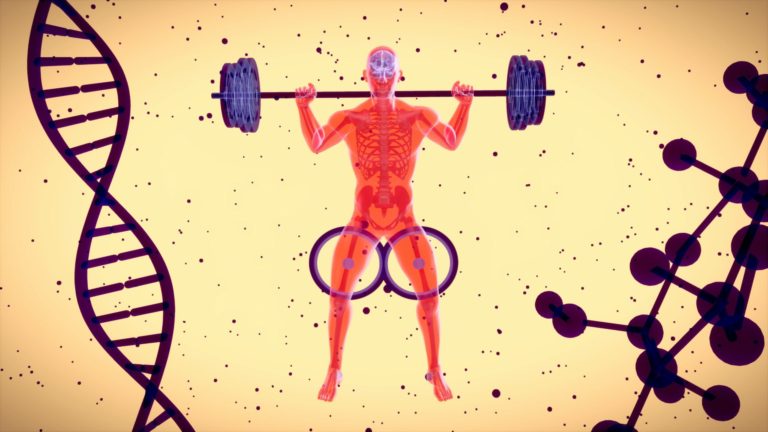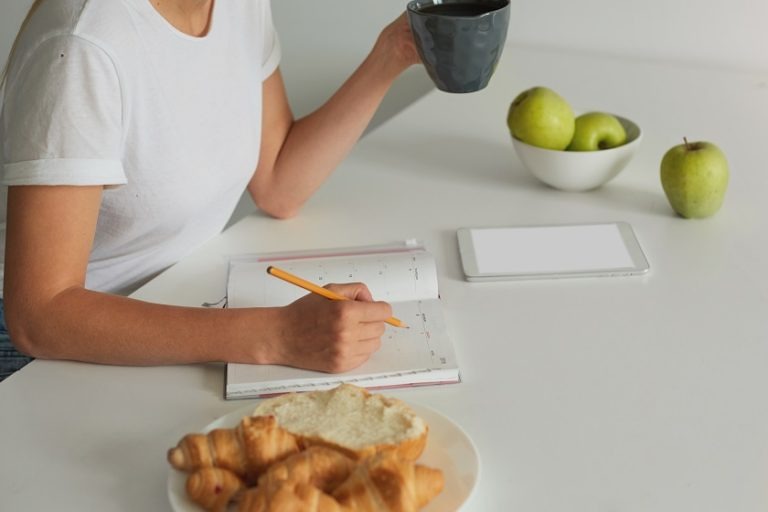The Taekwondo Stance is one of the most fundamental aspects of the art. The stance serves as the foundation for all techniques and a proper Taekwondo stance allows the practitioner to generate power, maintain balance, and defend against attacks. In this blog post, we will discuss the importance of stance in Taekwondo and provide techniques for mastering the various types of stances used in this martial art.
If you are not sure what Taekwondo is, please take a look at this post What is Taekwondo? All references are drawn from my experience in ITF Taekwondo, but Stances are fundamental in all Martial Arts.
Table of Contents
The Importance of Stance in Taekwondo
The stance is the foundation of all techniques in Taekwondo. It is the starting point from which movements originate and the point of balance upon which all techniques rely. Through proper stance, allows a practitioner to generate power in their strikes and kicks, maintain balance and stability, and defend against attacks.
Types of Taekwondo Stances
There are several different types of stances used in Taekwondo. The most common are the ready stance, the walking stance, and the Sitting Stance (horse stance). The ready stance, also known as the parallel stance, is the starting position for all techniques and forms. The walking stance is used for movement and the Sitting Stance (horse stance) is used for power generation and stance training. There also other types of stance like back stance, L-stance, etc.
Basic Taekwondo Stances For Beginners
Parallel (Ready) Stance – Narani (Junbe) Sogi
To perform the Ready stance in Taekwondo, spread the feet to shoulder width keeping the toes pointing forwards. Parallel Stance can be either be full facing or side facing.
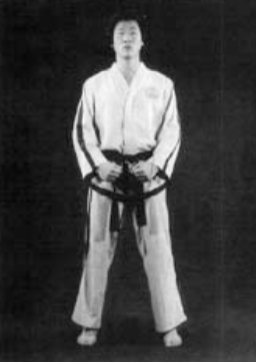
The proper positioning of the feet in Parallel Stance is with the toes pointing straight forward and the heels in line.
It is fundamental for the martial artist to practice and master the parallel stance since it will lay the foundation for more complex and advanced stances as well as techniques.
Attention Stance – Charyot Sogi
This is the Taekwondo attention stance that should be used at:
- The start and end of each class,
- At the start and end of working with a partner,
- The start and end of a sparring bought.

The Left Heel is brought together with the Right Heel, to form an Upside Down V-shape.
At the same time, take the fists (clenched) down naturally, bending slightly at the elbows. The position is liken to two outer forearm low side blocks. Eyes face the front, slightly above the horizontal line.
Remember this is from the Korean Military and so think about the military when they stand Tall to attention.

Sitting (Ready) Stance – Annun (Junbe) Sogi
The Taekwondo sitting stance is performed with the feet flat on the ground, facing directly forward and positioned one and a half shoulder widths apart and parallel to one another. The body weight is split evenly between both legs, with the knees bent moderately “until the knee caps come over the ball of the foot”. This stance is often used for punching exercises and building leg strength.
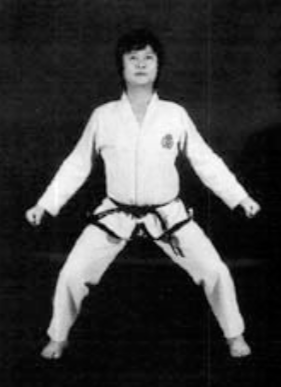
This stance can be used for training the legs, lower back and core muscles. It helps to improve balance, stability and power. The sitting stance is also suitable for handling an opponent’s pressure and can be used in some self-defence techniques.
The hands out to the side denote a “Ready” Posture.
Sitting (Ready) Stance
Walking (Ready) Stance – Gunnun (Junbe) Sogi
Walking Stance is a strong stance for front and rear, both in attack and defence.
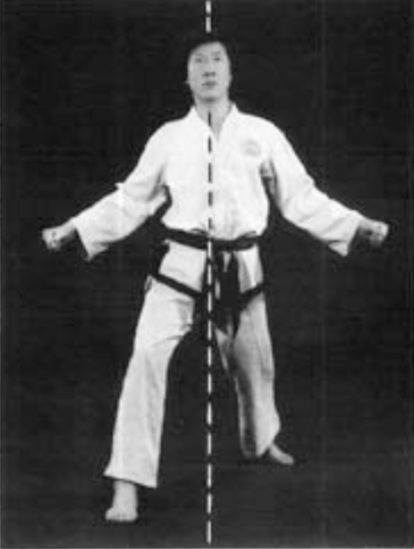
Move one foot to either the front or the rear at a distance of one and a half shoulder widths between the big toes and one shoulder width from one centre of the instep to the other. If the big toes are over one and a half shoulder width in distance then movement from this stance will be slow and weak against an attack from the side and weak against an attack from the front or the rear.
Bend the front leg until the knee cap forms a vertical line with the heal extending the other leg fully.
Distribute the body weight evenly on both feet.
Keep the toes of the front foot pointing forward and the opposite foot 25 degrees outward. If the rear foot is more than 25 degrees, this weakens the leg joint against an attack from the rear.
Tense the muscles of the feet with the feeling of pulling them toward each other.
When the right leg is at the front, the stance is called a right Walking Stance and when the left leg is at the front, it is called a left Walking Stance. It can either be full facing or half facing both in attack and defence.
The hands out to the side denote a “Ready” Posture.
The L-Stance
To perform the Taekwondo L Stance, place one foot forward and turn the other foot 90 degrees so that the feet form an L-Shape, one and a half shoulder widths from big toe to big toe.
There is no “width” to this stance but there will be a gap of 2.5cm (1 inch) between the line of the student’s heels.

Bend the rear leg until the knee cap forms a vertical line with toes and bend the front leg so that the knee is in a vertical line with the heel.
The Body weight is split 70% on rear leg and 30% on front leg.
If the Rear leg is the Right leg, you are performing a Right L-Stance.
The benefits of Taekwondo stance training
Benefits of Taekwondo stance training are not only for martial arts but also for daily life activities. The proper alignment of the body, balance, and power generation learned in stance training can help to improve posture and prevent injuries. This can be beneficial for people of all ages and fitness levels, as it can improve overall health and wellness and is especially important for older practitioners or those recovering from injuries.
How to Properly Execute a Taekwondo Stance
Executing a proper stance involves aligning the feet, hips, shoulders, and head in the correct position. The feet should be shoulder-width apart and pointed forward, with one foot slightly ahead of the other. The hips should be square to the front, and the shoulders and head should be aligned with the hips. It is also important to keep the back straight, the abdominal muscles engaged, and the weight distributed evenly on both feet.
Additionally, focusing on the mental and breathing aspect of the training while in stance can lead to stress relief and a better overall mental well-being. The discipline and focus required in stance training can also be helpful in other areas of life such as work and academics.
It’s also worth mentioning the different applications of the stance in actual sparring and self-defence scenarios. Discussing how to adapt the stance for different situations, and the importance of being able to switch between different stances quickly and smoothly can be valuable for practitioners who want to use their stance training in real-life situations.
Lastly, it’s important to note that stance training is ongoing and it’s a continuous process that never truly ends. It’s important to remind readers that even if they have mastered the basics of the stance, it’s important to keep practicing, keep learning and keep striving for self-improvement. To conclude, incorporating all of these elements will provide readers with a comprehensive guide on Taekwondo stance, including its benefits and applications, not just in the context of martial arts, but also in everyday life.
Tips for Improving Your Taekwondo Stances
One way to improve your stance is to practice stance drills and exercises. This can include horse stance holds, stance switches, and stance and movement combinations. Flexibility and strength training, specifically for the legs and core, can also aid in improving your stance. It’s important to pay attention to form and posture during training and drills. Practicing poomsae and forms can also help to improve your stance and overall Taekwondo technique.
Common Mistakes to Avoid in Taekwondo Stance
One of the most common mistakes in Taekwondo stance is not having the correct alignment of the feet. It is also common to have the weight too far forward or too far back, which can affect balance and power generation. This also applies if the feet are too wide or too narrow.
Another common mistake is not keeping the back straight or not engaging the abdominal muscles.
The difference between ITF and WTF style of Taekwondo
These are the two major federations that govern Taekwobdo globally and both have slight variations in terms of the stance, poomsae and forms. ITF style is considered to be more traditional and its roots are from the original founder of Taekwondo, General Choi Hong Hi. The WTF style (recently renamed WT), on the other hand, is more sport oriented and it’s the one that is used in Olympic competitions. The ITF style emphasises more on the self-defence aspect of Taekwondo, while the WTF style is focused on sport performance.
Conclusion: The Role of Stance in Mastering Taekwondo
In conclusion, stance is a fundamental aspect of Taekwondo and mastering it is crucial for improving overall technique. Proper alignment, balance, power generation, and flexibility are key components of a good stance. By practicing stance drills and exercises, and focusing on form and posture during training, practitioners can improve their Taekwondo stance and take their martial arts skills to the next level.
By including these additional keywords in your blog post, you can provide more in-depth information about the various aspects of Taekwondo stance and its importance in the martial art. The footwork, kihap, breathing, and mental focus are important elements that are related to the stance and should be considered while discussing and practicing stance techniques.
For advanced practitioners, it’s worth mentioning the difference between basic and advanced stance, and how they differ in terms of alignment, balance, and power generation. As well as, the muscle memory aspect of stance, which is the ability to perform a stance without conscious thought as the muscles have been trained to respond in a certain way.
Taekwondo Stance reproduced from Encyclopaedia Of Taekwondo, General Choi Hong Hi.


